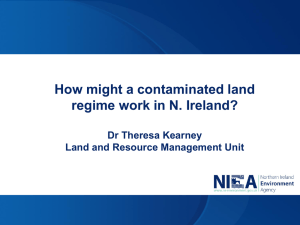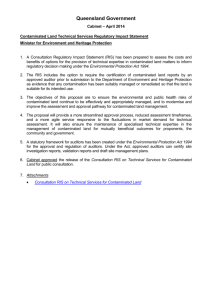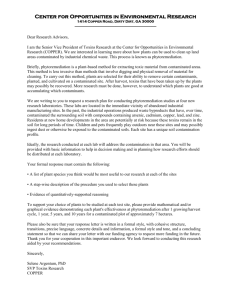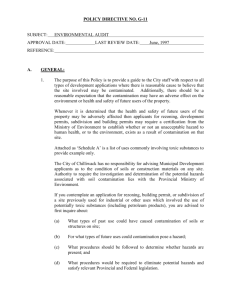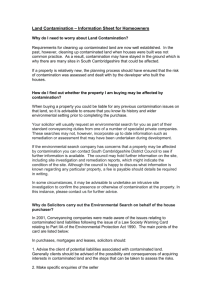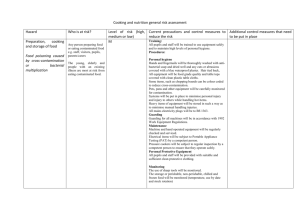Key-issues in regulating contaminated land in Europe
advertisement
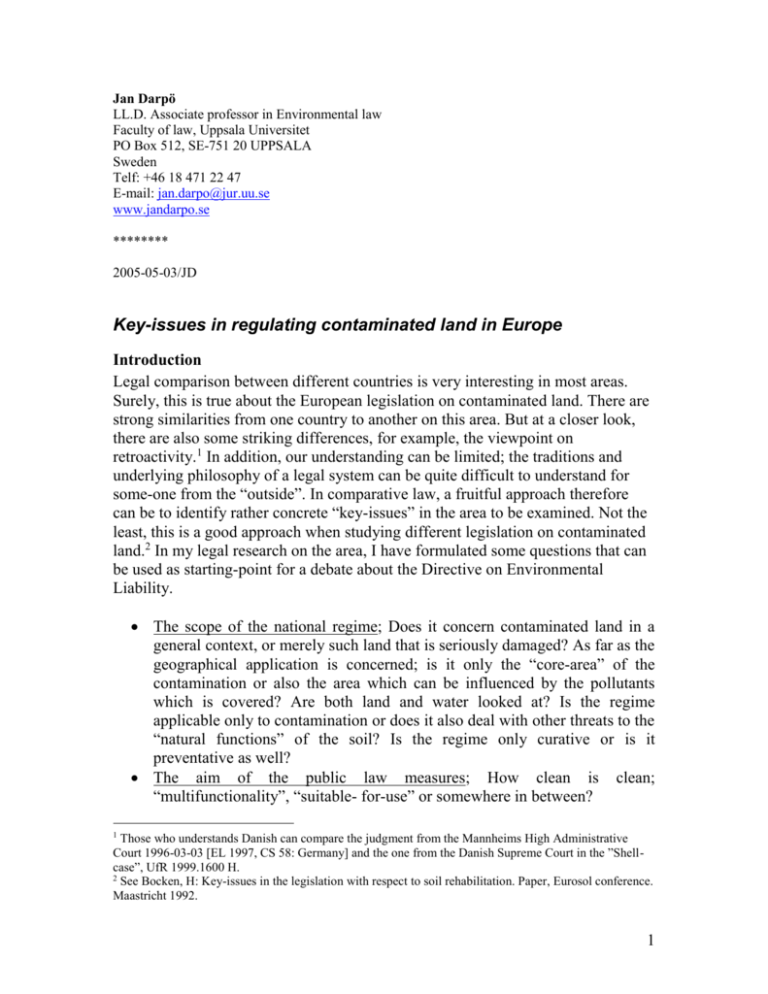
Jan Darpö LL.D. Associate professor in Environmental law Faculty of law, Uppsala Universitet PO Box 512, SE-751 20 UPPSALA Sweden Telf: +46 18 471 22 47 E-mail: jan.darpo@jur.uu.se www.jandarpo.se ******** 2005-05-03/JD Key-issues in regulating contaminated land in Europe Introduction Legal comparison between different countries is very interesting in most areas. Surely, this is true about the European legislation on contaminated land. There are strong similarities from one country to another on this area. But at a closer look, there are also some striking differences, for example, the viewpoint on retroactivity.1 In addition, our understanding can be limited; the traditions and underlying philosophy of a legal system can be quite difficult to understand for some-one from the “outside”. In comparative law, a fruitful approach therefore can be to identify rather concrete “key-issues” in the area to be examined. Not the least, this is a good approach when studying different legislation on contaminated land.2 In my legal research on the area, I have formulated some questions that can be used as starting-point for a debate about the Directive on Environmental Liability. The scope of the national regime; Does it concern contaminated land in a general context, or merely such land that is seriously damaged? As far as the geographical application is concerned; is it only the “core-area” of the contamination or also the area which can be influenced by the pollutants which is covered? Are both land and water looked at? Is the regime applicable only to contamination or does it also deal with other threats to the “natural functions” of the soil? Is the regime only curative or is it preventative as well? The aim of the public law measures; How clean is clean; “multifunctionality”, “suitable- for-use” or somewhere in between? 1 Those who understands Danish can compare the judgment from the Mannheims High Administrative Court 1996-03-03 [EL 1997, CS 58: Germany] and the one from the Danish Supreme Court in the ”Shellcase”, UfR 1999.1600 H. 2 See Bocken, H: Key-issues in the legislation with respect to soil rehabilitation. Paper, Eurosol conference. Maastricht 1992. 1 Registers; The fact of contamination or just the suspicion? Trigger-values; What do the values indicate and to what extent are they legally binding? The public law duties; Reporting and notification, investigation, remediation or ICM-methods (Isolating-Controlling-Monitoring). What is the understanding of the commonly used expression “reasonable” measures? Do the rules facilitate the use of “remediation-plans”. The addressees; Legal base for liability, polluters and landowners, several parties, the room for subjective factors (hardship and so on), retroactivity etc. In the following paper, I am discussing some of these questions. Typical legal issues relating to contaminated areas There are certain typical issues related to the specifics of contaminated areas as an environmental problem as such. These are for example: the scope of legislation for contaminated areas, the ambition of environmental measures, the use of environmental quality standards, the function and legal effects of registration, the use of certain “trigger values” (standards indicating a level of contamination where remediation or investigation must be carried out) and, finally, the content and scope of the legal duties to remediate. The scope of legislation for contaminated areas differs between the European states. In some countries, management of contaminated areas is regulated as one part of sector legislation, e.g. waste law (Finland). In others, legislation focuses specifically on areas that are already contaminated, or even seriously contaminated (U.K.). A third, wider approach is taken by countries who have adopted a comprehensive soil protection statutes with objectives to prevent soil from being polluted or otherwise damaged, to provide for measures to be taken in already contaminated areas, including to remove polluted soils, and finally to impose obligations on various parties to remediate. In Europe, only the Netherlands and Germany have adopted such a comprehensive legislation. Although one could discuss the necessity of covering all forms of damages (compaction, salinisation, erosion, etc.) to the soil within one and the same piece of legislation, this broad perspective certainly gives the best possibility of managing the environmental problem as a whole. In my opinion, a sustainable legal approach to contaminated areas should entail both prevention and reparation. Furthermore, the legislation should apply to all contaminated areas where the contaminants pose a risk which is not negligible to man or the environment. If only seriously contaminated sites are included, experiences show that the remediation will not be far reaching enough, as it stops at the point when the area is no longer seriously contaminated. 2 Registers are used in almost all countries, with varying legal effects. The most common system is to register only seriously polluted sites. The legal consequences differs from restrictions on development to an imperative for investigation and remediation of the area. There can be some problems when registers cover areas where contamination only is suspected. If these registers include areas for housing, the economic effects to the house owners can be substantial. Therefore, such registers should only cover industrial areas where the historic or present activities are of such a nature that contamination can be caused. Quality standards including numeric values are widely used within this area. They can, however, relate to different “levels” of contamination and to different situations. “Target values” (T-values) relate to “how clean is clean” and “Intervention values” (I-values) to the opposite, since they signal serious contamination. “Precaution values” (P-values) relate to investigation measures. There is a general tendency throughout Europe trying to make quality standards with numeric values legally binding. If such values are exceeded, they release requirements to carry out certain measures (investigation or remediation) and/or restrictions concerning how the area may be used. In my opinion, legally binding values should be used only to a limited extent in connection with contaminated areas. This is due to the difficulties in establishing the exact status of any contamination in soil. In addition, risk assessments almost always must be done on an individual basis, with respect to factors such as the type of soil, the paths for spreading and the type of public and private interests concerned. Finally, there are problems in linking a specific requirement on a person to the fact that a numeric value is exceeded. Therefore, legally binding I-values should only be used in relation to ground water pollution and to dangerous substances located in the top layer of the soil where human beings can be exposed to them. T-values should normally be used as guidelines for individual decisions. However, with regard to industrial sites, it should be possible to use legally binding P-values that trigger investigations in the area. When legal duties are discussed, the focus is on investigation and remediation. Here I find that the traditional public law duties and instruments should be complemented and improved with respect to the specific environmental problem. Industrial activities that employ pollutant substances in their processes should be faced with a duty to investigate the ground continually, at intervals. In fact, both in the Netherlands and in the U.K., such a requirement is already regarded as following from the EC IPPC-directive (“base line studies”). The legislation should also empower authorities to force the liable parties to present a “remediation plan”, including the entire project from start to finalisation, its costs and environmental effects. When it comes to remediation, the policy of “suitable for use” seems preferable. This means that the aim of remedying “historic pollution” should be to protect major environmental interests, such as clean drinking water 3 and ecologically sensitive areas. The major argument for this approach is that economic resources should be used where they give the greatest “environmental benefits”. It is of vital importance, however, that developing projects do not hinder future remediation. The aim of remedying contamination that has taken place after the introduction of modern environmental law (that is, in most countries, in the mid 1970s) should be multifunctionality. The only exceptions from this rule should be that such measures are technically impossible, or that the costs are clearly to high with respect to how the area is expected to be used in the future. Public law and/or private law European countries have different traditions with respect to dealing with liability for contaminated areas. Today, however, most countries have a modern public law regime, even if tort law elements sometimes are included. My conclusion is that the public law approach is preferable. The environmental problem as such demands for a preventative perspective: Only a “risk-assessment” perspective can take into account the fact that contaminated areas is an on-going problem. Legal requirements should therefore be addressed to the parties that currently have the possibility to deal with the problem. By contrast, the retrospective approach does not promote efficient implementation of the today’s environmental goals. Still, the tort law system can contribute solutions concerning such aspects as distribution of liability among several parties and the burden of proof. These solutions should, however, be used as a result of a conscious decision of the legislator. As the Danish example shows, a legal system based on public law, but to a considerable extent interpreted with support from tort law, creates confusion among those who implement the rules in practice. The system of civil procedure could also lend some ideas to public law implementation. There is a need to develop new instruments in these contexts, such as the possibility to call for joint hearings with several involved parties. The public law system should also indicate that authorities are allowed to use tort law to protect the public interest. Such use should, however, be in line with the Dutch “two road” doctrine (”twee weegenleer”), which means that these instruments should not be used in a manner that confuses the public law system or weakens the position of the individual. Liabilities of the polluters The “ideal” legal regime for contaminated areas uses a wide definition of “polluter”. The polluter should be determined according to an independent public law judgment which basically includes any party who controls the polluting activity. The regime also needs rules that prevent companies from being used to avoid liability. Furthermore, a rule of distribution of liability among several parties is needed. However, the rule of “joint and several” liability is in general not well suited to the situation of contaminated areas. The parties involved can often be 4 identified and their shares can be proportioned according to their contribution. In many situations, the most effective solution, and also the one that appears to be the fairest, is to address the obligation to remediate or investigate to the last polluter. The rule of “joint and several” liability should only be used when it is impossible to allocate the contributions. The rules for distributing liability among several parties should be complemented with the possibility for a “petty” polluter to be excluded or only to pay his share. The legal basis for liability should be objective according to public law criteria. Tort law factors such as fault put an often impossible onus on the authority to prove negligence and thereby contribute to the polluter not paying. The essence of PPP is instead that all environmental costs should be included in the price of the goods, irrespective of the subjective attitude of the operators. Such an objective public law liability should, however, be combined with the possibility of avoiding “hardship” in the individual case. Responsibilities of landowners To my knowledge, the legal regimes related to contaminated areas in Europe, comprise four legal constructions that determine landowner’s liabilities and responsibilities. First of all, the landowner can also be a polluter because of the close connection between him and the polluter or the polluting activity. Secondly, most countries have traditional legal constructions that entail responsibility for the landowner for what he keeps on his premises. In this way, passivity of the part of the landowner is not tolerated and brings about liability. Most of the legal regimes for contaminated areas also include a responsibility for the landowner to prevent contaminants spreading from his estate into the surroundings. Thirdly, to prevent polluters from escaping from liability, a landowner is often held liable if being a negligent purchaser of a contaminated estate. A person who buys such an estate with knowledge or constructed knowledge (the purchaser ought to know about the contamination) “steps into the polluter’s shoes” with respect to liability for investigation and remediation. Fourthly, the rule of “unjust enrichment” normally applies to landowners. It should be noted, though, that this legal obligation has been adopted by some countries, e.g. Germany, the Netherlands and Sweden, but not by e.g. U.K. and Denmark. I favor a legal regime based on substantial landowner liability. Two main arguments may be put forward for this conclusion. First, and most important, this is an effective way of counteracting polluters’ possibility to “dodge the liability”, by selling contaminated sites. A substantial landowner liability is therefore, indirectly, compatible with PPP. Second, the landowner is the most important agent in a legal regime with a preventative perspective. He or she knows about the 5 history of the site, is most able to undertake remediation measures and also enjoys the benefits of any measures taken. Time and retroactivity The time factor and retroactivity must also be discussed in this context. Here, an examination of case-law of the European Court of Justice on the subject shows that EC law applies two main principles. The first is called the “doctrine of the immediate applicability” of the EC rules. In short, this means that rules are not considered to be retroactive if the actual situation was not changed before the rules entered into force, e.g. when new legal requirements to remediate contaminated sites are used against a polluting activity still operating. The second principle is that EC law rests upon a presumption of prohibition against retroactive legislation. This presumption can, however, be departed from if the retroactive intention clearly follows from the statute’s wordings, objectives or general scheme. In both these cases, however, other EC principles to protect individuals must be respected, mainly the one of “legitimate expectations”. Discussing “legitimate expectations” in relation to contaminated areas, one can observe that in several countries it is considered that legislation can connect duties to prevent an on-going disturbance from an estate from affecting the surroundings, without being retroactive. Even in those countries that do not have this responsibility for “trusteeship”, it is argued that a requirement to take reparative measures does not infringe on any legitimate expectations of the liable person if the polluting activity was concluded after the introduction of a modern environmental legislation, comprising the requirement. 6
